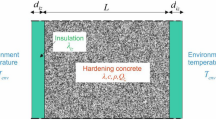Abstract
Hollow-core concrete blocks constitute the main method of construction for vertical walls in Lebanon where almost all walls are masonry and use the same block shape. The detailed investigation of the main parameters involved in the heat transfer in these blocks is thus of great importance for analyzing and understanding them and providing recommendations for their improvement. This paper offers an experimental and numerical analysis of heat performance the Lebanese concrete hollow block. After validating the numerical model by comparing it to experimental results, a deep and detailed analysis is done for understanding the complexity of heat transfer phenomena inside the block. Then a parametric study is performed to understand the effect of various parameters on the overall thermal resistance of the block, these parameters include the concrete solid mixture, the cavities infill material, and the geometry configuration of the block.


















Similar content being viewed by others
References
T.L. Bergman, A.S. Lavine, F.P. Incropera, D.P. Dewitt, Fundamentals of heat and mass transfer, 7th edn. (Wiley, Hoboken, 2011)
C. Caruana, C. Grima, C. Yousif, S. Buhagiar, R. Curmi, Determination of thermal characteristics of standard and improved hollow concrete blocks using different measurement techniques. J. Build. Eng. 13, 336–346 (2017). https://doi.org/10.1016/j.jobe.2017.09.005
C. Caruana, C. Yousif, P. Bacher, S. Buhagiar, C. Grima. Overview of testing methodologies for thermally improved hollow-core concrete blocks. 6th international conference on sustainability in energy and buildings, SEB-14, UK. (2014). https://doi.org/10.1016/j.egypro.2014.12.379
J.J. Coz Diaz, P.J. Garcia Nieto, J. Dominguez Hernandez, A. Suarez Sanchez, Thermal design optimization of lightweight concrete blocks for internal one-way spanning slabs floors by FEM. Energy Build. 41, 1276–1287 (2009)
G. De Vahl Davis, Natural convection f air in a square cavity, a benchmark numerical solution. Int. J. Numer. Methods Fluids 3, 249–264 (1983). https://doi.org/10.1002/fld.1650030305
M.A. Fogiatto, G.H. Santos, N. Mendes. Thermal transmittance evaluation of concrete hollow blocks. 12th international conference on heat transfer, fluid mechanics and thermodynamics, Spain. (2016)
E. Fraile-Garcia, J. Ferreiro-Cabello, M. Mendivil-Giro, Vicente-Navarro A. San, Thermal behavior of hollow blocks and bricks made of concrete doped with waste tyre rubber. Constr. Build. Mater. 176, 193–200 (2018). https://doi.org/10.1016/j.conbuildmat.2018.05.015
H. Kus, E. Özkan, O. Göcer, E. Edis, Hot box measurements of pumice aggregate concrete hollow block walls. Constr. Build. Mater. 38, 837–845 (2012). https://doi.org/10.1016/j.conbuildmat.2012.09.053
Y. Meng, T. Ling, K. Mo, Recycling of wastes for value-added applications in concrete blocks: an overview. Resour. Conserv. Recycl. 138, 298–312 (2018). https://doi.org/10.1016/j.resconrec.2018.07.029
B. Mohammed, A. Hossain, J. Swee, G. Wong, M. Abdullahi, Properties of crumb rubber hollow concrete block. J. Clean. Prod. 23, 57–67 (2011). https://doi.org/10.1016/j.jclepro.2011.10.035
P. Tittelein, S. Gibout, E. Franquet, L. Zalewski, D. Defer, Identification of thermal properties and thermodynamic model for a cement mortar containing PCM by using inverse method. Energy Procedia 78, 1696–1701 (2015). https://doi.org/10.1016/j.egypro.2015.11.265
B. Urban, P. Engelmann, E. Kossecka, J. Kosny. Arranging insulation for better thermal resistance in concrete and masonry wall systems. 9th Nordic symposium on building physics, Finland. (2011). https://doi.org/10.1016/j.applthermaleng.2017.04.163
J. Wang, S. Li, S. Guo, C. Ma, J. Wang, J. Sun, Analysis of heat transfer properties of hollow block wall filled by different materials in solar greenhouse. Eng. Agric. Environ. Food 10, 31–38 (2017). https://doi.org/10.1016/j.eaef.2016.07.003
J. Xamán, J. Cisneros-Carreño, I. Hernández-Pérez, I. Hernández-López, K.M. Aguilar-Castro, E.V. Macias-Melo, Thermal performance of a hollow block with/without insulating and reflective materials for roofing in Mexico. Appl. Therm. Eng. 123, 243–255 (2017). https://doi.org/10.1016/j.applthermaleng.2017.04.163
R. Xu, T. He, Y. Da, Y. Liu, J. Li, C. Chen, Utilizing wood fiber produced with wood waste to reinforce autoclaved aerated concrete. Constr. Build. Mater. 208, 242–249 (2019). https://doi.org/10.1016/j.conbuildmat.2019.03.030
Y. Xu, L. Jiang, J. Liu, Y. Zhang, J. Xu, G. He, Experimental study and modeling on effective thermal conductivity of EPS lightweight concrete. J. Therm. Sci. Technol. (2016). https://doi.org/10.1299/jtst.2016jtst0023
Z. Younsi, L. Zalewski, S. Lassue, D. Rousse, A. Joulin, A novel technique for experimental thermophysical characterization of phase-change materials. Int. J. Thermophys. 32, 674–692 (2011). https://doi.org/10.1007/s10765-010-0900-z
Y. Zhang, K. Dua, J. Hec, L. Yanga, Y. Li, S. Li, Impact factors analysis on the thermal performance of hollow block wall. Energy Build. 75, 330–341 (2014). https://doi.org/10.1016/j.enbuild.2014.02.037
L. Zhu, J. Dai, G. Bai, F. Zhang, Study on thermal properties of recycled aggregate concrete and recycled concrete blocks. Constr. Build. Mater. 94, 620–628 (2015). https://doi.org/10.1016/j.conbuildmat.2015.07.058
Author information
Authors and Affiliations
Corresponding authors
Additional information
Publisher's Note
Springer Nature remains neutral with regard to jurisdictional claims in published maps and institutional affiliations.
Rights and permissions
About this article
Cite this article
Sassine, E., Cherif, Y., Dgheim, J. et al. Experimental and Numerical Thermal Assessment of Lebanese Traditional Hollow Blocks. Int J Thermophys 41, 47 (2020). https://doi.org/10.1007/s10765-020-02626-7
Received:
Accepted:
Published:
DOI: https://doi.org/10.1007/s10765-020-02626-7




